Planetary Observations
Observing the planets
can be both interesting and fun, sometimes very picturesque as
well. Planets - derived from the Greek word 'Wanderers' explains
why they are called what they are called :-). In ancient times
people watched as these star like objects wandered across the
'fixed ' stars.
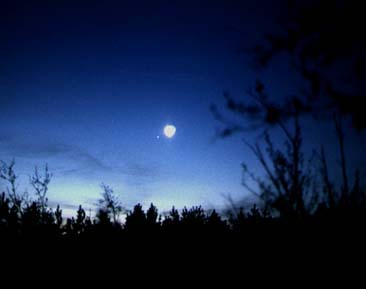 Venus and the Moon
in the Twilight. A static camera shot.
It can be great fun
just watching these as they pass through constellation to constellation
with the naked eye. You can even take image using a simple static
camera and a fast film with just a tripod and cable release.
Additionally of course
with a pair of reasonable binoculars you can see the moons of
Jupiter, and find Uranus in the night sky. With a small telescope
the rings of Saturn and its brighter moon Titan appears. These
gas giants also start to show their gaseous nature, and as the
telescope size increase more detail can be revealed on the surface
of these planets.
Venus and the Moon
in the Twilight. A static camera shot.
It can be great fun
just watching these as they pass through constellation to constellation
with the naked eye. You can even take image using a simple static
camera and a fast film with just a tripod and cable release.
Additionally of course
with a pair of reasonable binoculars you can see the moons of
Jupiter, and find Uranus in the night sky. With a small telescope
the rings of Saturn and its brighter moon Titan appears. These
gas giants also start to show their gaseous nature, and as the
telescope size increase more detail can be revealed on the surface
of these planets.
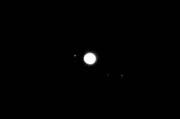 ...
... 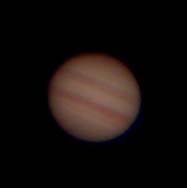 ...
... 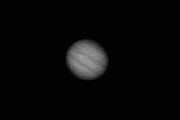 Images of Jupiter,
B & W showing the moons and the belts through a Meade 10"
LX200 with an Astrovid 2000 video camera.
The colour shot is
from an AP 6" f12 refractor, using a Sony DKC - CM30 digital
camera
With a small telescope
it's possible to see the phases of the inner planets Mercury Venus.
They can also be seen when transiting the Sun. Here they are seen
as small black discs. The next transit of Venus occurs 2004.
Images of Jupiter,
B & W showing the moons and the belts through a Meade 10"
LX200 with an Astrovid 2000 video camera.
The colour shot is
from an AP 6" f12 refractor, using a Sony DKC - CM30 digital
camera
With a small telescope
it's possible to see the phases of the inner planets Mercury Venus.
They can also be seen when transiting the Sun. Here they are seen
as small black discs. The next transit of Venus occurs 2004.
 The phases of Venus
using a Takahashi FS128, and Sony digital camera.
The phases of Venus
using a Takahashi FS128, and Sony digital camera.
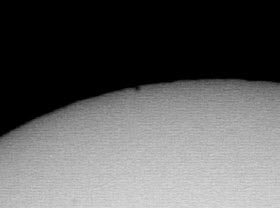 Transit of Mercury
- Nov 15th 1999 Meade ETX 90 with 2x OM converter and JVC TK1070
video camera from Death Valley USA.
Transit of Mercury
- Nov 15th 1999 Meade ETX 90 with 2x OM converter and JVC TK1070
video camera from Death Valley USA.
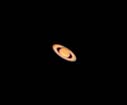 ............
............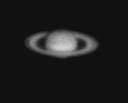 Two images of the ringed
planet. The colour with an Ap 6" f12 refractor, and the B
& W with an SBIG ST-7E CCD camera and a two times barlow
Two images of the ringed
planet. The colour with an Ap 6" f12 refractor, and the B
& W with an SBIG ST-7E CCD camera and a two times barlow
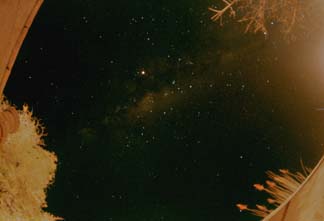 Our other close neighbour
Mars can be seen as a disk, and when opposition is favourable
features on the surface can be seen. Can you see any Canals ?
The opposition this
year is very unfavourable for the Northern Hemisphere, however
on a brief trip to Zimbabwe I managed a shot of the sky around
the region of Scorpio including Mars using a 16mm lens from the
bar area at the Kingdom Hotel - Victoria Falls.
Luckily Mars in 2003
is very close. Here is a quick shot using the FS128, 4x Powermate,
and the Basler digital camera with A4I Docu software.
Our other close neighbour
Mars can be seen as a disk, and when opposition is favourable
features on the surface can be seen. Can you see any Canals ?
The opposition this
year is very unfavourable for the Northern Hemisphere, however
on a brief trip to Zimbabwe I managed a shot of the sky around
the region of Scorpio including Mars using a 16mm lens from the
bar area at the Kingdom Hotel - Victoria Falls.
Luckily Mars in 2003
is very close. Here is a quick shot using the FS128, 4x Powermate,
and the Basler digital camera with A4I Docu software.
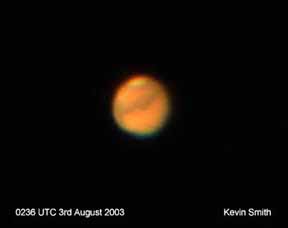 Both Uranus, and Neptune
are resolvable in small / medium sized scope, but Pluto is a little
more difficult needing a largish scope, and good Sky Charts. These
are often supplied by magazines like Sky & Telescope. Regular
observations will show movement against the background stars.
Today's CCD imagers are capable of this. It is one of my intentions
to capture both of these with ccd sometime.
Both Uranus, and Neptune
are resolvable in small / medium sized scope, but Pluto is a little
more difficult needing a largish scope, and good Sky Charts. These
are often supplied by magazines like Sky & Telescope. Regular
observations will show movement against the background stars.
Today's CCD imagers are capable of this. It is one of my intentions
to capture both of these with ccd sometime.
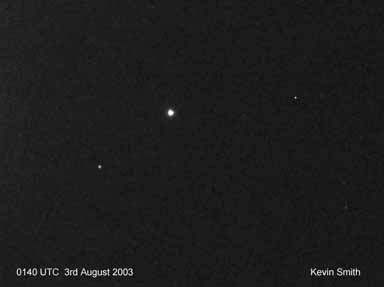 Here is a picture of
Uranus usingan FS128 at prime focus with a Stellacam. The magnitude
of the at this time was 5.7, but not visible to the naked eye
from my back garden. Image captured to DV video tape, and transfered
to a Sony Wlakman using ilink.
Also don't forget the
Asteroids or Minor Planets, they show up as streaks across long
exposures, and details of the larger known bodies are published
in the BAA handbook.
Occasionally you get
an alignment of the planets where early in the dawn or evening
sky it is possible to see all the naked eye planets together.
Such occasion occured in May of 2002. Here is a suitably labelled
image of such an alignment.
Here is a picture of
Uranus usingan FS128 at prime focus with a Stellacam. The magnitude
of the at this time was 5.7, but not visible to the naked eye
from my back garden. Image captured to DV video tape, and transfered
to a Sony Wlakman using ilink.
Also don't forget the
Asteroids or Minor Planets, they show up as streaks across long
exposures, and details of the larger known bodies are published
in the BAA handbook.
Occasionally you get
an alignment of the planets where early in the dawn or evening
sky it is possible to see all the naked eye planets together.
Such occasion occured in May of 2002. Here is a suitably labelled
image of such an alignment.
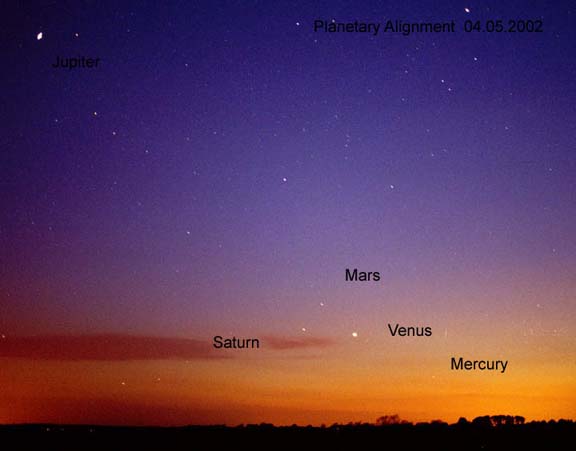 Imaged from Cirencester
using an Olympus OM1 and Fuji Sensia 400 film. Scanned with a
Polaroid Sprintscan 4000, and tweaked in Adobe Photoshop. A range
of exposiures from 5 - 40 seconds were employed to bracket and
get all the planets visible..
Astronomy
Main . ..Astronomical
Imaging ..Home
Imaged from Cirencester
using an Olympus OM1 and Fuji Sensia 400 film. Scanned with a
Polaroid Sprintscan 4000, and tweaked in Adobe Photoshop. A range
of exposiures from 5 - 40 seconds were employed to bracket and
get all the planets visible..
Astronomy
Main . ..Astronomical
Imaging ..Home

